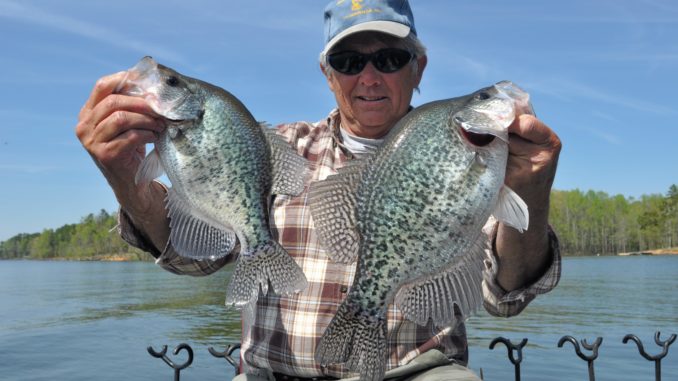
When it comes to numbers and size, this expansive lake might just boast North Carolina’s best crappie fishery.
John H. Kerr Reservoir once had the reputation as a top-drawer lake to catch largemouth bass, striped bass and catfish.
That’s changed the past several years as Largemouth Bass Virus and gill maggots have taken their toll on bass and stripers, but catfishing has improved steadily. The lake’s reputation wasn’t hurt by last year’s world-record 147-pound blue cat.
But Kerr, aka Buggs Island, hasn’t been widely acknowledged as a crappie factory. Perhaps that’s because so many top-notch crappie venues elsewhere in North Carolina, or maybe its sprawling nature (49,500 surface acres) complicates finding crappie haunts.
But make no mistake. If you wrote the names of heralded crappie factories on slips of paper — Jordan, Falls of the Neuse, Shearon Harris, High Rock and Kerr — and made knowledgeable crappie fishermen conduct a blind draw, the ones who didn’t pull Kerr would be disappointed.
One of the lake’s top crappie fishermen is Bud Haynes of Clarksville, Va. A veteran guide, he’s been targeting white crappie, perciformes annularis more often since the lake’s rockfish and bass populations nose dived.
However, in March, the water is usually still too cool for crappie to head to woody cover along the 800 miles of shoreline and begin the spring spawn. Most of Kerr’s crappies, especially egg-laden females sometimes weighing as much as three pounds, stage at creek channels in feeder streams.
The problem for anglers is to pick a tributary, find the right depth and structure and have the hottest lures. Some creeks hold more and larger crappies than others, and that’s when it takes an expert such as Haynes to find concentrations of larger fish.
Haynes, a 64-year-old Viet Nam veteran, is part of a group of dedicated crappie anglers that fishes nearly every Saturday in wildcat tournaments. These guys guard their hot slab spots like Brinks guards tending a gold shipment.
Haynes has a few tricks that put him ahead of the game — years of experience, a depthfinder, a loaded-with-best-trees GPS unit and lures he makes that are absolute slab slayers.
“Most of the crappies in Buggs in March are gonna be on deep structure,” he said, “at places in pretty deep water. By that I mean ‘trash’ — and boat docks or boat houses.”
“Trash” to Hayes isn’t discarded bottles or tires, but sunken trees, usually Christmas trees.
“The lake must have thousands of ’em,” he said. “Actually, it’s got too many to my way of thinking.”
Haynes has the location of 400 sunken trees loaded into his GPS, many in two creeks — Bluestone and Buffalo — convenient to his Clarksville, Va., home.
“There are other good creeks on the lake, but these two are close so I don’t have to run far,” he said.
Haynes uses three techniques to land March crappies: trolling, casting or “shooting” docks. Trolling seems to put the most fish in his boat, but casting to structure or dock shooting usually lands more slabs.
Although this survey of top Kerr Lake crappie spots includes only two creeks, others also hold spring crappies.
At the northern end, they include Butcher, Eastland, Rudds, Buckhorn, Grassy and Mill. The Nutbush Creek arm of the lake contains crappies at Little Nutbush, Flat, Burroughs Mill and Big Mill creeks.
“You have to pick the creek you want to fish,” Haynes said. “Crappie fishing isn’t like a bass tournament; you don’t run-and-gun here and there. You find a spot and fish it. It’s a good idea to come to one creek, learn it and fish it. That’s how to catch Buggs Island crappie.”
This crappie king agreed to show us some of his best spots:
1 — Bluestone Bridge
36 39 851 N/78 34 395 W
This spot at the US 15 bridge at Bluestone Creek is about 150 yards off the north shore of the bridge on the creek side.
“There are some sunken trees at this spot,” Haynes said. “Sometimes the crappie get stacked up in here on the trees pretty good.”
The water depth off the shoreline ranges from 15 to 25 feet.
Haynes often starts his fishing run at this and similar spots by spider-rig trolling. He slow-trolls his lures — mostly a smaller, modified version of the Hellgramite lures he uses for smallmouth bass — on a 1/16th-ounce jighead from one to three feet deep.
“Crappie sit in the water kind of angled, with their heads pointing up, and their eyes are on the front and tops of their heads, so they’re always lookin’ up for baits,” he said. “They’ll come up to hit a lure, but they won’t go down because they can’t see what’s below them.”
2 — Bluestone Dock
36 39 709 N/78 34 757 W
“This is one of my favorite docks,” Haynes said. “I’ve caught a lot of crappie here.”
Other boat docks up and down the creek’s shoreline and also can serve as crappie magnets.
“I like the docks close to deeper water for March fishing,” Haynes said.
If an angler is going to fish these docks, however, he needs to learn how to “shoot” docks, a long-standing technique.
Shooting a dock involves flipping open the bail on a spinning reel, letting out about a half-rod length of line, pinching a crappie jig between one’s fingers, pulling back on the line to put a bow in the rod, then releasing the jig and line at the same time to skip the jig underneath a dock or similar structure.
“It takes practice to learn how to do this,” Haynes said. “I cut the hooks off a jig and practiced in the hallway of my house. My wife got a little upset when I chipped holes in the ceiling, but I learned.”
Once a jig skitters, then starts to sink, the angler flips the bail closed and reels in just enough line to bring it taut so he can feel a crappie bite.
“They like to be in shadow, which the dock or pontoon gives ’em, and they like being deep when the water’s still pretty cold,” Haynes said.
3 — Tall Pines Point
36 39 917 N/78 34 743 W
Haynes designates one of his favorite trolling areas by a shoreline landmark. He likes to slow-troll jigs, sometimes tipped with live minnows, on six to eight rods.
“The fish move into the creeks during January and February, and they stage offshore until March when they move to wood to spawn,” he said. “So I’m out here trolling for them if I’m not at a dock or fishing trash.”
Haynes likes to troll in 20 feet of water about 50 feet off the shore at this point that’s directly north of the Bluestone boat ramp.
“I just troll up and down this area, a couple hundred yards,” he said. “I might go from one side of the creek channel to the other.”
Trolling is an effective way, Haynes said, to pick up a lot of fish.
“I’ve been spider-rigging for only three years, but you can pick up a lot of fish that way,” he said.
4 — Buffalo Creek channel
36 38 959 N/78 38 535 W
The entire creek channel upstream from the mouth of Buffalo Creek to the US 58 bridge is a good place to troll as well.
“The best place to troll here in March is the middle of the creek,” Haynes said. “It’s a preferred spot for trollers during January, February and March. Sometimes, there’ll be 50 boats trolling Buffalo Creek in March.”
But crappie can move in and out of deep to shallow water, depending on weather patterns.
Haynes said he took a friend to Buffalo last year, and they caught 75 nice crappies.
“He came back the next day with a friend, and they weren’t doing much trolling so they moved to the shoreline,” he said. “They caught 300 crappies, right up on the bank. And another guy did the same thing that day in Grassy Creek.
“Crappie pulled up on the banks for three days all over the lake, then they went back out.”
5 — Bluestone Brushpile
36 40 626 N/78 34 450 W
This spot, between the nearby point on the right and a boat dock across Bluestone Creek, has a brushpile near the right side of the creek that Haynes placed in the lake.
The way he fishes brushpiles almost guarantees landing large crappie during March.
Once he motors to “trash” (a sunken tree), which may be in 20 to 30 feet of water, depending upon the lake level (usually high in early spring), Haynes drops an orange float right on top of the tree. Then he backs off 30 to 40 feet away, nice casting distance, and tosses one of his Hellgramite lures at the orange float.
“If you see on your depth-finder the top of the tree is 10 feet from the surface, when the lure hits the water, count down 1, 2, 3, etc., to 10, then start reeling slowly,” he said.
Crappie, seeing a bait falling toward them, get excited when they watch it trying to swim away, charge out of the tree and slam the lure.
Haynes uses Mitchell Avocet 2000 and Abu-Garcia reels with 6 1/2 to 7-foot rods. His favorite crappie tricksters are 1 1/2-inch-long green-and-white Bud’s Hellgramite Lures he makes and uses with 1/16-ounce round jigheads. The most effective Hellgramites have citrus-colored tails.
6 — Between the Bridges Cove
36 40 621 N/78 34 606 W
This cove is between US 15 and VA 49 and is a favorite trolling spot.
“It’s got so many sunken trees I don’t put them in my GPS,” Haynes said.
“It’s a good place to troll, or you can pick out one of the trees and drop a float and cast and count down, then retrieve.”
7 — Rocky Shoreline
36 40 163 N/ 78 34 429 W
This shoreline is filled with rocks and is a good place to find crappie during late March when the water temperature rises near the 60-degree mark.
“The sun warms up the rocks and brings in baitfish and that brings in the crappie,” Haynes said.
Many sunken logs are scattered along the shoreline among the rocks.
“In March it’s a good place to troll in front of because the fish stage in this cove, waiting for the water to warm up, then they move shallow,” Haynes said.
8 — House on the Hill Cove
36 40 231 N/78 34 479 W
This cove is another good trolling area farther up the lake in Bluestone Creek.
In the middle of this expansive open area of water, the depth is 16 feet, so as boats move closer to the shore, it becomes clear this a mostly shallow-water staging area for crappie about to move to the shoreline to spawn.
“I like to troll in this cove,” Haynes said. “It’s got a lot of crappie, and I’ve caught a lot of limits here.”
9 — Bluestone Ramp
36 40 348 N/78 34 338 W
This area for trolling is just across the cove from the Bluestone launch ramp to the northwest about halfway to the point at the far north.
“It’s got 11 feet of water and is another good trolling spot,” Haynes said.
“During March crappie will be schooling in this area and you should just slow troll back and forth in front of this bank.”
10 — House Through the Trees
36 40 431 N/78 34 332 W
This spot is directly across from the Bluestone ramp.
“It’s got a lot of submerged trees in this area of the lake, and it’s another good trolling spot,” he said.
“The crappie get in the trees and will come up to take lures.”
A ramp juts out from the shoreline to mark this spot.
Bud Haynes can be contacted at 434-374-0348.

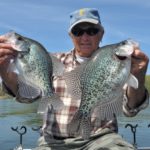
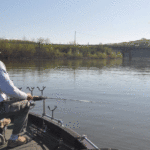
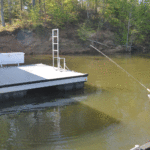
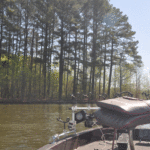
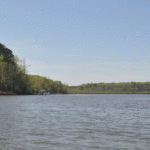
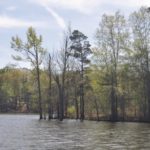
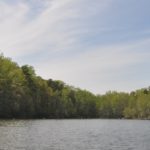
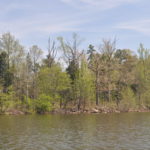
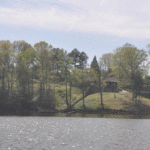
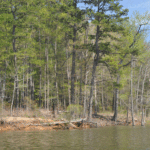
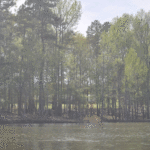




Be the first to comment